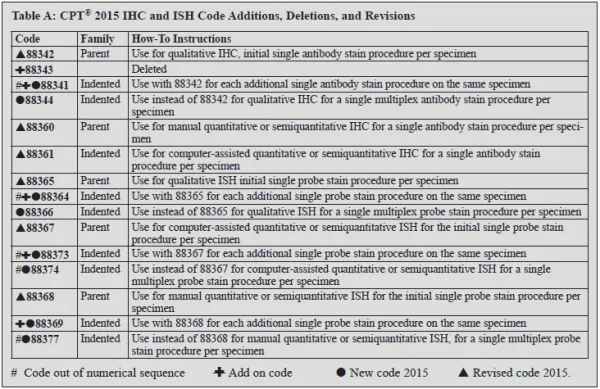Revamp Your IHC and ISH Reporting With 2015 'Makeover'
Look for parallel construction to simplify coding.
After a year of dealing with contradictions among immunohistochemistry (IHC) and in situ hybridization (ISH) codes, CPT® 2015 brings some much-needed order.
Take our crash course on the structure and usage of multiple revised code families to simplify your IHC and ISH coding next year. Along with Table A on page 83, the following tips should make your 2015 coding as easy as ABC.
Tip A: Code Per Specimen
When CPT® 2014 revised qualitative IHC codes, lots of confusion surrounded terms like “per block” and “per slide.” These unit-of-service changes created an inequity between qualitative IHC versus ISH and quantitative IHC. The changes also sent Medicare down the road of requiring HCPCS Level II codes for qualitative IHC rather than paying for the stains per block.
Enter CPT® 2015 with a clear addition to each IHC and ISH code: “per specimen.” Look at Table A to see that each code contains this statement in the common part of the parent code.
Watch future pages of Pathology/Lab Coding Alert to see how these changes will impact payment, and whether Medicare will accept the revised codes instead of requiring the “G” codes for qualitative IHC.
“Regardless of how the Medicare payment pans out, the “per specimen” clarification is a welcome relief for pathology practices trying to create and follow coherent charge policies for these services,” says R.M. Stainton Jr., MD, president of Doctors’ Anatomic Pathology Services in Jonesboro, Ark.
Tip B: See What Stays the Same
CPT® 2015 still distinguishes IHC and ISH codes based on whether the procedures are qualitative (88342 and 88365 code families) versus quantitative/semiquantitative, which CPT® calls “morphometric analysis” (88360, 88367 and 88368 code families).
The new code set also continues to divide the morphometric analysis codes based on whether the procedure is manual (88360, 88368) or computer assisted (88361, 88367).
Tip C: Identify First Single Stain Procedure
Each code family in Table A begins with a parent code for the first, single stain procedure. You can see this parallel structure in each of the following revised CPT® 2015 codes (emphasis added):
Tip D: Add-On Subsequent Single Stains
In addition to revised codes for “initial single stain” for 2015, you’ll also find new, indented, add-on codes to report additional single stains in CPT® 2015, as follows (emphasis added):
Because these are add-on codes, expect most payers to require you to bill a primary code before they’ll pay for any of these codes for additional stains.
Tip E: Use New Multiplex Procedure Codes
Prior to CPT® 2015 changes, you didn’t have a consistent way to code for multiplex IHC and ISH services. These are tests that identify multiple antibodies or probes in a single procedure.
For instance: A single prostate triple stain such as PIN4 contains three antibodies that differentially stain various cell types in prostate specimens. The 2014 code set attempted to provide for this and similar stains by adding +88343 (Immunohistochemistry or immunocytochemistry, each separately identifiable antibody per block, cytologic preparation, or hematologic smear; each additional separately identifiable antibody per slide [List separately in addition to code for primary procedure]). But Medicare declined to pay for this code, and the other IHC and ISH codes did not address the multiplex concept. CPT® deletes the code in 2015.
Look to the following new CPT® 2015 codes to report multiplex IHC and ISH procedures next year (emphasis added):
Notice: Unlike the codes for each additional single stain, these multiplex stain codes are not add-on codes. Although CPT® 2015 indents each code under a parent code, the parent and child codes have an either/or relationship. In other words, you should either use the parent code for the first single-stain procedure, or you should use the appropriate indented code for a multiplex stain procedure.


